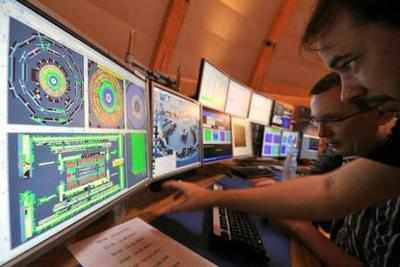- News
- Science News
- Scientists find 2 new subatomic particles at CERN
This story is from November 20, 2014
Scientists find 2 new subatomic particles at CERN
Experiments at the world's biggest particle smasher have confirmed the existence of two theorized subatomic particles, the European Organization for Nuclear Research (CERN) said on Wednesday.

Experiments at the world's biggest particle smasher have confirmed the existence of two theorized subatomic particles, the European Organization for Nuclear Research (CERN) said on Wednesday.
PARIS: Experiments at the world's biggest particle smasher have confirmed the existence of two theorized subatomic particles, the European Organization for Nuclear Research (CERN) said on Wednesday. The discoveries, known as Xi_b'- and Xi_b*-, are part of the baryon family of particles, it said.
Baryons are composite particles comprising three quarks bound together by the so-called strong force. Protons and neutrons are types of baryons.Xi_b'- and Xi_b*- had been predicted in theories, but it took experiments at CERN's Large Hadron Collider (LHC) near Geneva to find them.
The work was carried out at the facility's LHCb detector in 2011 and 2012, CERN said. A paper reporting the finding has been submitted to the journal Physical Review Letters.
The LHC shot to global fame in 2012 when it unearthed the Higgs boson, the particle that is believed to confer mass. It was a major piece in the 'Standard Model' of physics, a theory that describes the basic particles of matter, how they interact and the forces between them.
The new Xi_b particles each contains one "beauty" quark, one "strange" quark and one "down" quark, CERN said, referring to some of the unusual names for this clan of elementary particles. Where the two differ is in the so-called spin of the two lighter quarks in their configuration.
A related baryonic particle called Xi_b*0 was found by the CMS experiment at CERN in 2012.
"Nature was kind and gave us two particles for the price of one," said one of the CERN collaborators, Matthew Charles, of the CNRS's LPNHE laboratory at Paris VI University.
Baryons are composite particles comprising three quarks bound together by the so-called strong force. Protons and neutrons are types of baryons.Xi_b'- and Xi_b*- had been predicted in theories, but it took experiments at CERN's Large Hadron Collider (LHC) near Geneva to find them.
The work was carried out at the facility's LHCb detector in 2011 and 2012, CERN said. A paper reporting the finding has been submitted to the journal Physical Review Letters.
The LHC shot to global fame in 2012 when it unearthed the Higgs boson, the particle that is believed to confer mass. It was a major piece in the 'Standard Model' of physics, a theory that describes the basic particles of matter, how they interact and the forces between them.
The facility is going through an upgrade to operate at higher energies from early 2015.
The new Xi_b particles each contains one "beauty" quark, one "strange" quark and one "down" quark, CERN said, referring to some of the unusual names for this clan of elementary particles. Where the two differ is in the so-called spin of the two lighter quarks in their configuration.
A related baryonic particle called Xi_b*0 was found by the CMS experiment at CERN in 2012.
"Nature was kind and gave us two particles for the price of one," said one of the CERN collaborators, Matthew Charles, of the CNRS's LPNHE laboratory at Paris VI University.
End of Article
FOLLOW US ON SOCIAL MEDIA
